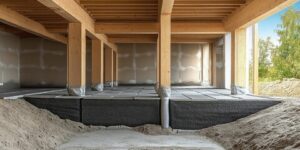Basement remodeling is an increasingly popular way to maximize the use of available space in a home while enhancing its functionality and value. Often overlooked and underutilized, basements have the potential to be transformed into versatile living spaces that serve various purposes, from entertainment areas to home offices, guest suites, and fitness rooms.

A well-executed basement remodel not only improves the overall livability of a home but also increases its market value and aesthetic appeal. With careful planning and thoughtful design, a basement can be turned into a comfortable and stylish extension of the main living area.
The process of basement remodeling begins with a thorough assessment of the existing space and its structural conditions. Unlike above-ground rooms, basements often present unique challenges such as low ceilings, limited natural light, moisture issues, and uneven floors. Addressing these factors is essential to creating a functional and comfortable environment. Professional remodeling contractors typically start by inspecting the foundation, walls, and flooring to identify any signs of water damage, mold, or structural weakness. Resolving these issues before beginning construction ensures that the remodeled space is safe, dry, and structurally sound. Proper waterproofing, ventilation, and insulation are critical to maintaining a comfortable and healthy indoor environment.
Once the structural issues have been addressed, the next step is to develop a design plan that reflects the homeowner’s lifestyle and needs. The versatility of a basement allows for a wide range of design options, from creating a cozy family room with a fireplace and built-in shelving to designing a modern home theater with state-of-the-art audio and visual equipment. Open-concept layouts are popular for basements, as they create a sense of spaciousness and allow for flexible use of the area. Adding partition walls, sliding doors, or decorative screens can help define separate zones within the basement while maintaining an open feel.
Lighting is a crucial element in basement remodeling due to the limited availability of natural light. Recessed lighting, track lighting, and wall sconces are popular choices for providing consistent and adjustable illumination. Incorporating reflective surfaces, such as mirrors and glass accents, helps distribute light more effectively and creates a brighter, more inviting atmosphere. If windows are available, maximizing their size and placement can enhance natural light flow and improve ventilation. Light color palettes for walls, flooring, and furnishings further contribute to the sense of openness and brightness.
Flooring selection plays a significant role in the comfort and functionality of a remodeled basement. Basements are prone to moisture, so it is important to choose materials that are resistant to water and humidity. Engineered wood, luxury vinyl planks, and ceramic tile are popular options due to their durability and moisture resistance. Carpeting can add warmth and comfort but requires proper moisture control to prevent mold and mildew growth. Radiant floor heating is a popular upgrade for basements, as it provides consistent warmth and enhances overall comfort, especially in colder climates.
Basement remodeling also presents an opportunity to improve the home’s energy efficiency. Installing proper insulation in the walls and floors helps maintain consistent indoor temperatures and reduces heating and cooling costs. Energy-efficient windows, LED lighting, and smart climate control systems contribute to long-term energy savings and environmental sustainability. Soundproofing the basement is another valuable upgrade, particularly if the space will be used as a media room, music studio, or home office. Acoustic insulation, soundproof drywall, and heavy curtains help minimize noise transfer between the basement and other areas of the home.
Creating a functional and visually appealing basement involves selecting furniture and décor that complement the overall design theme. Modular furniture and built-in storage solutions maximize space and provide flexibility for different activities. Soft furnishings such as area rugs, throw pillows, and upholstered seating add comfort and warmth. Decorative elements like artwork, wall treatments, and accent lighting personalize the space and reflect the homeowner’s style. Incorporating natural materials, such as wood and stone, creates a timeless and inviting atmosphere that blends seamlessly with the rest of the home.
For homeowners looking to generate additional income or accommodate extended family members, converting a basement into a rental unit or guest suite is an attractive option. A well-designed basement apartment includes essential amenities such as a separate entrance, kitchenette, bathroom, and living area. Compliance with local building codes and zoning regulations is essential when creating a separate living unit. Adding fire exits, proper ventilation, and soundproofing ensures the safety and comfort of occupants. A self-contained basement unit provides a valuable source of passive income and increases the overall value of the property.
Basement remodeling also opens up opportunities for creating specialized spaces tailored to specific interests and hobbies. A home gym equipped with workout machines, mirrors, and rubber flooring creates a convenient and motivating environment for exercise. A wine cellar with climate control and custom shelving provides an elegant space for wine storage and tasting. A craft room with ample storage and natural light encourages creativity and organization. The adaptability of a basement allows homeowners to design a space that meets their unique needs and enhances their lifestyle.
Entertainment spaces are particularly popular in basement remodels. A home theater with a large screen, surround sound, and comfortable seating creates a cinematic experience within the home. A game room with a pool table, arcade machines, and board games offers a fun and social environment for family and friends. A wet bar with built-in cabinetry, a sink, and a mini-fridge provides a convenient space for serving drinks and snacks during gatherings. Thoughtful lighting, soundproofing, and seating arrangements contribute to a comfortable and enjoyable entertainment experience.
Home offices and workspaces have become increasingly important as remote work becomes more common. A basement remodel provides an opportunity to create a dedicated office with ergonomic furniture, proper lighting, and soundproofing. Built-in shelving and filing cabinets maximize storage and organization. Natural light and greenery enhance the working environment and promote productivity. A separate office space in the basement allows for greater focus and separation between work and home life.
For families with children, a basement playroom offers a safe and organized space for toys, games, and creative activities. Soft flooring, durable furniture, and ample storage create a kid-friendly environment that is easy to maintain. Wall-mounted chalkboards, activity tables, and reading nooks encourage imaginative play and learning. A well-designed playroom provides children with a dedicated space to explore and express themselves while keeping the main living areas of the home clutter-free.
A successful basement remodel requires careful planning, skilled craftsmanship, and attention to detail. Hiring experienced contractors and design professionals ensures that the project is completed on time, within budget, and to a high standard of quality. Clear communication between homeowners and contractors helps prevent misunderstandings and ensures that the final result meets expectations. Permits and inspections may be required for structural changes, electrical work, and plumbing installations. Adhering to building codes and safety regulations ensures that the remodeled basement is compliant and safe for occupancy.
The financial investment in basement remodeling yields long-term benefits in terms of increased property value and enhanced living space. A well-designed basement adds functional square footage to a home and appeals to potential buyers seeking versatile and modern living arrangements. Energy-efficient upgrades, quality materials, and thoughtful design contribute to the long-term durability and performance of the remodeled space. The return on investment for basement remodeling projects varies depending on the scope of work, local real estate market conditions, and the overall quality of the renovation.
Ultimately, basement remodeling transforms an underutilized space into a valuable and inviting part of the home. The flexibility of basement design allows homeowners to create a space that meets their lifestyle needs and personal preferences. Whether used as an entertainment hub, guest suite, home office, or specialty room, a remodeled basement enhances the comfort, functionality, and value of the home. Careful planning, expert craftsmanship, and attention to detail ensure that the finished basement reflects the homeowner’s vision and serves as a source of pride and enjoyment for years to come.



